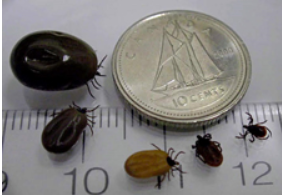May 2nd, 2024
BURLINGTON, ON
As temperatures start to climb this time of year, the Ontario government is encouraging people across the province to take precautions to prevent tick bites and reduce the risk of contracting Lyme disease and other tick-borne diseases, when enjoying the outdoors.
Lyme disease and other tick-borne diseases can cause potentially serious infections if you’re bitten by an infected blacklegged tick, commonly called a deer tick. If you have any symptoms such as fever, headache, chills, muscle and joint pain, fatigue and an expanding circular rash that resembles a bulls-eye, consult a health care provider as soon as possible.
“As we start enjoying the warmer weather again, it is important that we all take steps to protect ourselves and loved ones from tick bites and tick-borne diseases,” said Sylvia Jones, Deputy Premier and Minister of Health. “Blacklegged ticks are continuing to spread to new areas of the province, but by being proactive, we can combat the risk they pose and safely enjoy the beauty of Ontario over the coming months.”
If you are living, working, visiting, or enjoying outdoor activities in a wooded area, or an area with tall grass and bushes (including city gardens and parks) you are at greater risk of being bitten by a tick. You can protect yourself from tick bites by:
- Wearing light-coloured clothing, so it’s easier to spot ticks.
- Wearing long-sleeved shirts, long pants tucked into your socks, closed-toed shoes, or any special clothing designed to repel ticks.
- Applying insect repellent containing DEET or icaridin on your exposed skin and your clothes.
- Checking yourself, your children, and your pets for ticks after being outdoors. Any ticks found should be removed promptly.
- Putting your clothes on high heat in a dryer for at least 10 minutes before washing them, after spending time outdoors.
Ticks are very small and hard to see. When found, it should be removed immediately using fine-tipped tweezers to grasp the tick as close to your skin as possible without crushing it. Once you have removed a tick, wash your skin with soap and water and then disinfect your skin and your hands with rubbing alcohol or an iodine swab. Before disposing of the tick, call or check the website of your local public health unit to get advice on how to identify the tick. You can also submit a photo of the tick to etick.ca for identification.
“As areas where ticks can be found continue to grow, so to do the risks of tick bites and tick-borne diseases,” said Dr. Kieran Moore, Chief Medical Officer of Health. “By being vigilant, wearing appropriate clothing and doing routine tick checks, we can avoid tick bites and ensure our trips outside are safe and healthy, in the months ahead.”
If you have any health concerns after a tick bite, consult a health care provider as soon as possible. Most cases of Lyme disease can be treated successfully with antibiotics, and pharmacists have been able to prescribe medication to treat tick bites to prevent Lyme disease since January 1, 2023.




















